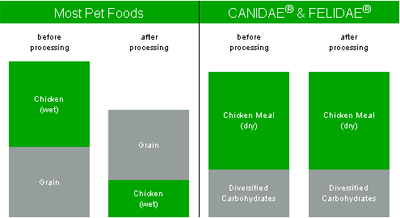Meat vs Meal
Meat vs. Meal on Pet Food Labeling. What is the difference and what does it mean to your pets and you.
Meat Fact: Chicken & Lamb are 70% water and only 12% protein.
Pet food labels found in grocery and mass marketers like to use Chicken or Lamb to represent real meat. When used without the addition of meat meals, these protein sources contain 70% moisture, much of which is lost during cooking. The label leads the consumer to believe that the product is mostly meat based when it may not be. Chicken or lamb meats are heavier than grains prior to cooking, but not after. Although the inclusion of fresh meats may be beneficial, the moisture contained in the meats (70%) is reduced by two-thirds during the cooking process, possibly leaving the total formula as a grain based food after processing.
Meal Fact: Chicken Meal and Lamb Meal are dry and 70% to 65% meat protein!
Example: CANIDAE All Life Stages lists Chicken Meal & Turkey Meal as the first ingredients. Chicken, Turkey and Lamb meals are nearly dry (5% moisture content) and contain 70% to 65% meat proteins. During cooking, the meat meals do not shrink below the grain weight, producing a true meat based formula for your pets. See the table below.
Meat vs. Meal - Where should it really end up in the ingredient panel?
- Ingredients are listed on pet food packaging in order of predominance BEFORE they are cooked.
- Meat Meal is highly concentrated meat that is dehydrated, containing 5% moisture and 70% protein.
- Meat is wet, containing 70% water and only 12% protein.
- When meat is cooked in the extrusion process, the moisture is removed, resulting in a very small percentage of the total makeup of the finished pet food.
- When meat meal is cooked in the extrusion process, it is not diminished, resulting in a much larger makeup of the finished pet food.
- Although meat has its benefits, it really shouldn?t be the only animal protein source available for your pets as you would wind up with a grain based pet food.







